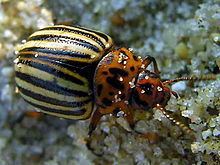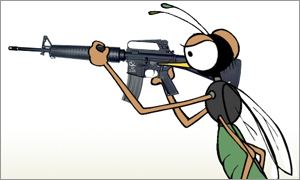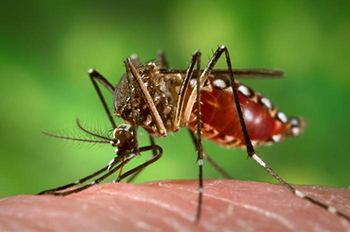Entomological warfare set up
Entomological warfare (EW) is a type of biological warfare that uses insects to attack the enemy. The concept has existed for centuries and research and development have continued into the modern era. EW has been used in battle by Japan and several other nations have developed and been accused of using an entomological warfare program.
Contents
- Entomological warfare set up
- Amesh adalja potential for the use of gene drives in entomological warfare
- Description
- Early history
- Canada
- France
- Germany
- Japan
- United Kingdom
- Soviet Union
- United States
- Bioterrorism
- Legal status
- Genetically engineered insects
- References

Amesh adalja potential for the use of gene drives in entomological warfare
Description

Entomological warfare (EW) is a specific type of biological warfare (BW) that uses insects in a direct attack or as vectors to deliver a biological agent, such as plague or cholera. Essentially, EW exists in three varieties. One type of EW involves infecting insects with a pathogen and then dispersing the insects over target areas. The insects then act as a vector, infecting any person or animal they might bite. Another type of EW is a direct insect attack against crops; the insect may not be infected with any pathogen but instead represents a threat to agriculture. The final method of entomological warfare is to use uninfected insects, such as bees, to directly attack the enemy.
Early history

Entomological warfare is not a new concept; historians and writers have studied EW in connection to multiple historic events. A 14th century plague epidemic in Asia Minor that eventually became known as the Black Death (carried by fleas) is one such event that has drawn attention from historians as a possible early incident of entomological warfare. That plague's spread over Europe may have been the result of a biological attack on the Crimean city of Kaffa.

According to Jeffrey Lockwood, author of Six-Legged Soldiers (a book about EW), the earliest incident of entomological warfare was probably the use of bees by early humans. The bees or their nests were thrown into caves to force the enemy out and into the open. Lockwood theorizes that the Ark of the Covenant may have been deadly when opened because it contained deadly fleas.

During the American Civil War the Confederacy accused the Union of purposely introducing the harlequin bug in the South. These accusations were never proven, and modern research has shown it more likely that the insect arrived by other means. The world did not experience large-scale entomological warfare until World War II; Japanese attacks in China were the only verified instance of BW or EW during the war. During, and following, the war other nations began their own EW programs.
Canada

Among the Allied Powers, Canada led the pioneering effort in vector-borne warfare. After Japan became intent on developing the plague flea as a weapon, Canada and the United States followed suit. Cooperating closely with the United States, Dr. G.B. Reed, chief of Kingston's Queen's University's Defense Research Laboratory, focused his research efforts on mosquito vectors, biting flies, and plague infected fleas during World War II. Much of this research was shared with or conducted in concert with the United States.
Canada's entire bio-weapons program was ahead of the British and the Americans during the war. The Canadians tended to work in areas their allies ignored; entomological warfare was one of these areas. As the U.S. and British programs evolved, the Canadians worked closely with both nations. The Canadian BW work would continue well after the war, including entomological research.
France
France is known to have pursued entomological warfare programs during World War II. Like Germany, the nation suggested that the Colorado potato beetle, aimed at the enemy's food sources, would be an asset during the war. As early as 1939 biological warfare experts in France suggested that the beetle be used against German crops.
Germany
Germany is known to have pursued entomological warfare programs during World War II. The nation pursued the mass-production, and dispersion, of the Colorado potato beetle (Lepinotarsa decemlineata), aimed at the enemy's food sources. The beetle was first found in Germany in 1914, as an invasive species from North America. There are no records that indicate the beetle was ever employed as a weapon by Germany, or any other nation during the war. Regardless, the Germans had developed plans to drop the beetles on English crops.
Germany carried out testing of its Colorado potato beetle weaponization program south of Frankfurt, where they released 54,000 of the beetles. In 1944, an infestation of Colorado potato beetles was reported in Germany. The source of the infestation is unknown, speculation has offered three alternative theories as to the origin of the infestation. One option is Allied action, an entomological attack, another is that it was the result of the German testing, and still another more likely explanation is that it was merely a natural occurrence.
Japan
Japan used entomological warfare on a large scale during World War II in China. Unit 731, Japan's infamous biological warfare unit led by Lt. General Shirō Ishii, used plague-infected fleas and flies covered with cholera to infect the population in China. The Japanese military dispersed the insects by spraying them from low-flying airplanes and dropping bombs filled with a mixture of insects and disease. Localized and deadly epidemics resulted and nearly 500,000 Chinese died of disease. An international symposium of historians declared in 2002 that Japanese entomological warfare in China was responsible for the deaths of 440,000.
The late Ban Shigeo, a technician at the Japanese Army's 9th Technical Research Institute, left a rare and valuable account of the activities of Noborito Research Institute, which was published in Rikugun Noborito Kenkyujo no shinjitsu – The Truth About the Army Nororito Institute (available only in the Japanese language). Of the Japanese Army's ten numbered institutes, only the 9th Army Technical Research Institute came under the covert operations section of the Army General Staff's Second Bureau (Intelligence). On the sensitive issue of Japanese biological warfare, Ban did not shrink from including an account of his trip to Nanking in 1941 to participate in the testing of poisons on Chinese prisoners. One of his book's contributions is to further tie Noborito to the Japanese Army's infamous Unit 731, which participated in biomedical research. When the war ended, the US Army quietly enlisted certain members of Noborito in its efforts against the communist camp in the early years of the Cold War. The author notes near the end of the book that Ban led the "chemical section" of a US clandestine unit hidden within Yokosuka naval base during the Korean War, and then worked on unspecified projects inside the United States from 1955 to 1959, before returning to Japan to enter the private sector. Shirō Ishii of Unit 731, having not been charged as a war criminal, also continued his work to consult with American authorities, especially during the height of the Cold War, and died in 1959 of throat cancer.
In 1989, a British study of Unit 731 strongly supported the theory of United States-Japanese BW culpability in Korea. Chinese experts insist today that BW weapons created in an American-Japanese collaboration were used in the Korean war.
Further evidence that Japanese continued to assist the United States chemical, biological warfare, as well as radiological effects and entomological warfare program efforts continued after the Korean war into Vietnam includes a visit to Rocky Mountain Arsenal in September 1962 by Japanese delegation I-63.
Among many other activities, from January 1962 – October 1969, Rocky Mountain Arsenal "grew, purified and biodemilitarized" plant pathogen wheat stem rust [Puccinia graminis, var. tritici] (Agent TX) for the Air Force biological anti-crop program. TX-treated grain was grown at the Arsenal from 1962–1968 in Sections 23-26. Unprocessed TX was also transported from Beale AFB for purification, storage, and disposal.
Trichothecenes mycotoxin is a toxin that can be extracted from wheat stem rust and rice blast and can kill or incapacitate depending on the concentration used. The "red mold disease" of wheat and barley in Japan is prevalent in the region that faces the Pacific Ocean. Toxic trichothecenes, including nivalenol, deoxynivalenol, and monoace tylnivalenol (fusarenon-X) from Fusarium nivale, can be isolated from moldy grains. In the suburbs of Tokyo, an illness similar to "red mold disease" was described in an outbreak of a food borne disease, as a result of the consumption of Fusarium-infected rice.
Ingestion of moldy grains that are contaminated with trichothecenes has been associated with mycotoxicosis.
United Kingdom
A British scientist, J.B.S. Haldane, suggested that Britain and Germany were both vulnerable to entomological attack via the Colorado potato beetle. In 1942 the United States shipped 15,000 Colorado potato beetles to Britain for study as a weapon.
Soviet Union
The Soviet Union researched, developed and tested an entomological warfare program as a major part of an anti-crop and anti-animal BW program. The Soviets developed techniques for using insects to transmit animal pathogens, such as foot and mouth disease—which they used ticks to transmit. The nation also used avian ticks to transmit Chlamydophila psittaci to chickens. In addition, the Soviet Union claimed to have developed an automated mass insect breeding facility, capable of outputting millions of parasitic insects per day.
United States
The United States seriously researched the potential of entomological warfare during the Cold War. The United States military developed plans for an entomological warfare facility, designed to produce 100 million yellow fever-infected mosquitoes per month. A U.S. Army report titled "Entomological Warfare Target Analysis" listed vulnerable sites within the Soviet Union that the U.S. could attack using entomological vectors. The military also tested the mosquito biting capacity by dropping uninfected mosquitoes over U.S. cities.
North Korean and Chinese officials leveled accusations that during the Korean War the United States engaged in biological warfare, including EW, in North Korea. The claim is dated to the period of the war, and has been thoroughly denied by the U.S. In 1998, Stephen Endicott and Edward Hagermann claimed that the accusations were true in their book, The United States and Biological Warfare: Secrets from the Early Cold War and Korea The book received mixed reviews, some called it "bad history" and "appalling", while other praised the case the authors made. Other historians have revived the claim in recent decades as well. The same year Endicotts' book was published Kathryn Weathersby and Milton Leitenberg of the Cold War International History Project at the Woodrow Wilson Center in Washington released a cache of Soviet and Chinese documents which revealed the North Korean claim was an elaborate disinformation campaign.
During the 1950s the United States conducted a series of field tests using entomological weapons. Operation Big Itch, in 1954, was designed to test munitions loaded with uninfected fleas (Xenopsylla cheopis). Big Itch went awry when some of the fleas escaped into the plane and bit all three members of the air crew. In May 1955 over 300,000 yellow fever mosquitoes (Aedes aegypti) were dropped over parts of the U.S. state of Georgia to determine if the air-dropped mosquitoes could survive to take meals from humans. The mosquito tests were known as Operation Big Buzz. Operation Magic Sword was a 1965 U.S. military operation designed to test the effectiveness of the sea-borne release of insect vectors for biological agents. The U.S. engaged in at least two other EW testing programs, Operation Drop Kick and Operation May Day. A 1981 Army report outlined these tests as well as multiple cost-associated issues that occurred with EW. The report is partially declassified—some information is blacked out, including everything concerning "Drop Kick"—and included "cost per death" calculations. The cost per death, according to the report, for a vector-borne biological agent achieving a 50% mortality rate in an attack on a city was $0.29 in 1976 dollars. Such an attack was estimated to result in 625,000 deaths.
The United States has also applied entomological warfare research and tactics in non-combat situations. In 1990 the U.S. funded a $6.5 million program designed to research, breed and drop caterpillars. The caterpillars were to be dropped in Peru on coca fields as part of the American War on Drugs. As recently as 2002 U.S. entomological anti-drug efforts at Fort Detrick were focused on finding an insect vector for a virus that affects the opium poppy.
Bioterrorism
Clemson University's Regulatory and Public Service Program listed "diseases vectored by insects" among bioterrorism scenarios considered "most likely". Because invasive species are already a problem worldwide one University of Nebraska entomologist considered it likely that the source of any sudden appearance of a new agricultural pest would be difficult, if not impossible, to determine. Lockwood considers insects a more effective means of transmitting biological agents for acts of bioterrorism than the actual agents. Insect vectors are easily gathered and their eggs easily transportable without detection. Isolating and delivering biological agents, on the other hand, is extremely challenging and hazardous.
In one of the few suspected acts of entomological bioterrorism an eco-terror group known as The Breeders claimed to have released Mediterranean fruit flies (medflies) amidst an ongoing California infestation. Lockwood asserts that there is some evidence the group played a role in the event. The pest attacks a variety of crops and the state of California responded with a large-scale pesticide spraying program. At least one source asserted that there is no doubt that an outside hand played a role in the dense 1989 infestation. The group stated in a letter to then Los Angeles Mayor Tom Bradley that their goals were twofold. They sought to cause the medfly infestation to grow out of control which, in turn, would render the ongoing Malathion spraying program financially infeasible.
Legal status
The Biological and Toxic Weapons Convention (BWC) of 1972 does not specifically mention insect vectors in its text. The language of the treaty, however, does cover vectors. Article I bans "Weapons, equipment or means of delivery designed to use such agents or toxins for hostile purposes or in armed conflict." It would appear, due to the text of the BWC, that insect vectors as an aspect of entomological warfare are covered and outlawed by the Convention. The issue is less clear when warfare with uninfected insects against crops is considered.
Genetically engineered insects
It has been suggested that insects could get genetically engineered via technologies such as CRISPR to create GMO "killer mosquitoes" that cause plagues that wipe out staple crops.
